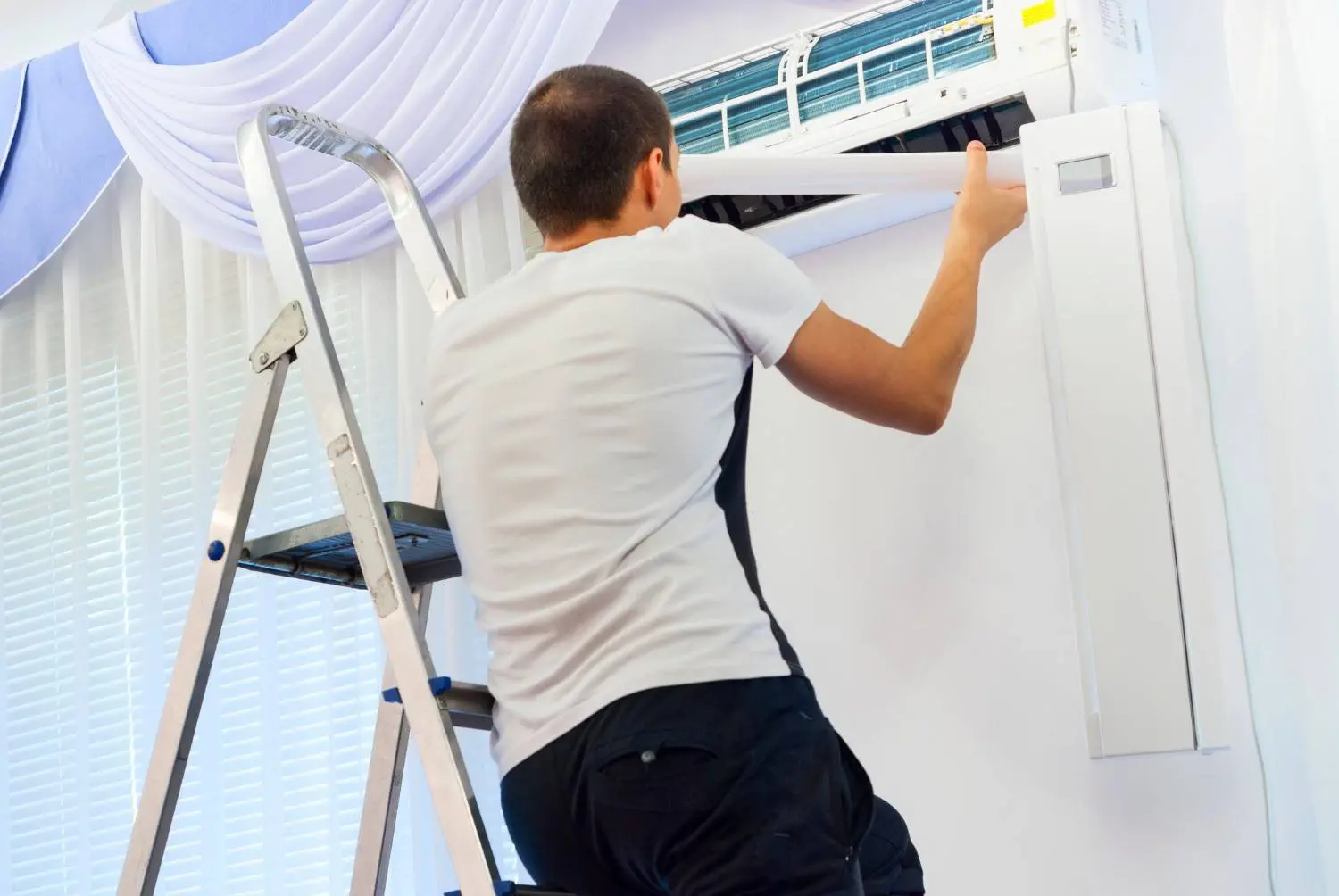Mini Split Installation in Minneapolis, MN
Get expert mini split installation in Minneapolis, MN from Stafford Home Service. Efficient heating and cooling in every room. Schedule your install today.
Mini Split Installation in Minneapolis, MN
Mini-split AC systems have revolutionized home climate control, offering a versatile, energy-efficient solution for cooling and heating individual zones within a property. Unlike traditional central air conditioning, mini-splits operate without extensive ductwork, making them an ideal choice for additions, renovated spaces, or older homes where installing ductwork is impractical or too costly. At Stafford Home Service, we understand the nuances of these advanced systems and are dedicated to providing clear, comprehensive information regarding their installation, functionality, and benefits.
The Appeal of Mini Split Systems
Ductless mini-splits consist of an outdoor compressor/condenser unit and one or more indoor air-handling units, connected by a conduit housing the power cable, refrigerant tubing, and a condensate drain. This design allows for highly flexible placement and superior energy efficiency.
Key benefits include:
- Zoned Comfort: Each indoor unit can be controlled independently, allowing you to set different temperatures in different rooms. This eliminates wasted energy in unoccupied areas and caters to individual comfort preferences.
- Energy Efficiency: Without ducts, mini-splits avoid the energy losses associated with ductwork in central forced air systems. Many models are ENERGY STAR® certified, leading to significant savings on utility bills.
- Flexible Installation: Their compact size and lack of ductwork mean mini-splits can be installed in virtually any room, even those without windows or external walls.
- Improved Air Quality: Some models feature advanced filtration systems that can reduce allergens, dust, and other airborne particles, contributing to a healthier indoor environment.
- Quiet Operation: Indoor units are designed to operate very quietly, ensuring minimal disturbance.

Choosing the Right Mini Split System
Selecting the appropriate mini-split system is crucial for optimal performance and energy efficiency. Several factors play a role in this decision:
- Cooling and Heating Capacity (BTUs): This is perhaps the most critical factor. The BTU rating determines how effectively the system can cool or heat a space. Factors like room size, ceiling height, insulation quality, number of windows, and sun exposure all influence the required BTU. An undersized unit will run constantly without reaching the desired temperature, while an oversized unit will cycle too frequently, leading to poor dehumidification and increased wear and tear.
- Energy Efficiency Rating (SEER/HSPF): The Seasonal Energy Efficiency Ratio (SEER) measures cooling efficiency, and the Heating Seasonal Performance Factor (HSPF) measures heating efficiency. Higher ratings indicate greater energy savings.
- Single-Zone vs. Multi-Zone: Single-zone systems feature one outdoor unit connected to one indoor unit, ideal for conditioning a single room. Multi-zone systems connect one outdoor unit to multiple indoor units (typically 2-8), each controllable independently, perfect for conditioning several rooms or an entire home.
- Features and Technology: Consider features like inverter technology for variable speed operation (enhancing efficiency and comfort), remote control options, Wi-Fi connectivity, sleep modes, and specialized air filtration.
- Brand and Warranty: Reputable brands often offer better reliability and comprehensive warranties, providing peace of mind for your investment.
Understanding Mini Split Installation Costs
The total cost of a mini split installation is a significant consideration for many homeowners. While we do not provide specific pricing, we can detail the factors that influence the overall investment:
- System Type and Capacity: Higher BTU systems, multi-zone configurations, and models with advanced features or higher SEER ratings will naturally cost more than basic single-zone units.
- Number of Indoor Units: Each additional indoor unit in a multi-zone system adds to the equipment and labor costs.
- Installation Complexity: Factors like the distance between indoor and outdoor units, the need for extensive line set routing, wall types (e.g., brick vs. drywall), and the difficulty of accessing installation areas can increase labor time and material costs.
- Electrical Work: Mini-split systems require dedicated electrical circuits. If your home's electrical panel needs upgrades or new wiring run, this will add to the overall cost.
- Ancillary Materials: This includes line sets, condensate pumps, mounting brackets, and any aesthetic covers for the conduit.
- Labor Costs: Professional installation involves skilled technicians to ensure correct sizing, proper refrigerant charging, electrical connections, and system testing. Labor rates vary based on regional economic factors and the complexity of the job.
While the initial investment for a mini split can be higher than some portable or window units, the long-term energy savings and enhanced comfort often provide a substantial return on investment.
DIY vs. Professional Mini Split Installation
The internet offers numerous resources for DIY projects, including mini split installation guides. While some "DIY-ready" kits are available, a full mini split installation is a complex task best left to certified professionals.
DIY Installation Considerations:
- Required Tools: Specialized tools like a vacuum pump, manifold gauge set, flare tools, and refrigerant recovery equipment are essential. These are often expensive and require specific training to use safely.
- Technical Knowledge: Proper electrical wiring, refrigerant handling, line set evacuation, and leak detection require precise technical knowledge. Mistakes can lead to system damage, refrigerant leaks (which are harmful to the environment and illegal to release), electrical hazards, and voided warranties.
- Safety Risks: Working with electricity and pressurized refrigerants poses significant safety risks if not handled correctly.
- Warranty Issues: Most manufacturers require professional installation for warranty validity. Incorrect DIY installation will often void your warranty, leaving you responsible for costly repairs or replacements.
When to Hire a Professional:
Professional installation ensures that your mini split system is sized correctly, installed safely, and operates at peak efficiency. Professionals are trained to:
- Accurately Size the System: Prevent issues of undersizing or oversizing.
- Comply with Codes: Ensure all electrical and HVAC installations meet local building codes and safety regulations.
- Handle Refrigerant Safely: Minimize environmental impact and ensure proper system performance.
- Optimize Placement: Choose the best indoor and outdoor unit locations for efficiency and aesthetics.
- Provide Warranty Protection: Maintain your system's warranty validity.
- Offer Expert Advice: Guide you through system selection, operation, and maintenance.
For reliable and safe mini split installation, Stafford Home Service provides expert service, ensuring your system is installed correctly the first time.
Maintenance and Troubleshooting Tips
Even with professional installation, regular maintenance is key to the longevity and efficiency of your mini split system.
Routine Maintenance:
- Clean Air Filters: Check and clean or replace air filters monthly or as needed. Clogged filters restrict airflow, reduce efficiency, and can lead to coil freeze-ups.
- Clean Indoor Unit Coils: Annually, have a professional clean the evaporator coils to remove dirt and mold buildup.
- Clear Condensate Drain Line: Ensure the drain line is free of clogs to prevent water leaks and mold growth.
- Clean Outdoor Unit: Keep the outdoor compressor/condenser unit free of debris, leaves, and dirt. Ensure adequate clearance around the unit for proper airflow.
- Professional Tune-Ups: Schedule annual professional maintenance to inspect refrigerant levels, electrical connections, and overall system performance.
Common Issues and Troubleshooting:
- No Cooling/Heating: Check thermostat settings, circuit breaker, and air filters. If still not working, it could indicate a refrigerant leak or compressor issue requiring professional attention.
- Water Leaks from Indoor Unit: Often caused by a clogged condensate drain line or a frozen evaporator coil (due to dirty filters or low refrigerant).
- Unusual Noises: Rattling, buzzing, or grinding noises could indicate a loose component, a failing motor, or other mechanical issues.
- Reduced Airflow: Typically a sign of dirty air filters or an obstruction in the indoor unit.
Frequently Asked Questions About Mini Split Installation
How long does mini split installation take?
The installation time varies depending on the system type (single-zone vs. multi-zone), the number of indoor units, and the complexity of the installation. A single-zone system might take 4-8 hours, while a multi-zone system could take 1-2 days.
Can mini splits provide both heating and cooling?
Yes, most modern mini-split systems are heat pumps, meaning they can both cool during warmer months and provide efficient heating during colder months.
Do mini splits require special wiring?
Yes, mini-split systems typically require a dedicated 240-volt circuit. An experienced electrician or HVAC professional will ensure the electrical setup meets all safety codes.
Where is the best place to install the indoor unit?
Indoor units are best placed on an interior wall that allows for easy routing of the line set to the outdoor unit. Considerations also include optimal airflow distribution within the room and aesthetic preference.
How often should I have my mini split system serviced?
It is generally recommended to have your mini split system professionally serviced annually to ensure it operates efficiently, extends its lifespan, and maintains warranty validity.
Secure Your Comfort with Professional Mini Split Installation
Investing in a mini split system is a smart decision for efficient, zoned comfort in your home. From selecting the right BTU capacity to understanding the nuances of electrical requirements and refrigerant handling, the installation process demands precision and expertise. While the allure of DIY can be strong, the complexities and potential risks associated with mini split installation make professional service the most reliable and safest choice.
For a seamless and efficient mini split installation that adheres to the highest standards, trust the experienced professionals at Stafford Home Service. We ensure your system is perfectly sized, expertly installed, and fully optimized to deliver unparalleled comfort and energy savings for years to come.
Schedule your professional mini split installation with Stafford Home Service today.
Maintenance plan
Our premium maintenance plans start at just $216 annually, providing regular tune-ups, priority scheduling, and comprehensive protection to keep your systems running efficiently year-round.
Customer Testimonials
Our customers consistently praise our knowledgeable technicians, prompt service, and the lasting quality of the work we deliver.






